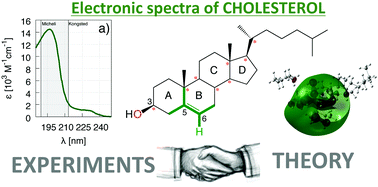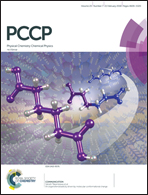Revisiting absorption and electronic circular dichroism spectra of cholesterol in solution: a joint experimental and theoretical study†
Abstract
Cholesterol is doubtless one of the most studied bio-molecules, which unfortunately features low emitting properties, precluding its in vivo study by fluorescence experiments. The design of fluorescent analogues of cholesterol is thus an appealing challenge in biochemistry, which simultaneously requires minor changes in its chemical structure (to retain main biological properties) and considerable enhancement of light emission. To this aim, the photochemical behaviour of the native molecule has to be deeply understood. In this work, we focused our attention on the electronic absorption of cholesterol in several common organic solutions, combining experimental (through ultraviolet-visible and electronic circular dichroism spectroscopy) and theoretical approaches (at the time-dependent density functional theory level) in order to solve the important discrepancies previously reported in the literature on the maximum absorption wavelengths and on the nature (Rydberg and/or π → π*) of the associated electronic transition.



 Please wait while we load your content...
Please wait while we load your content...